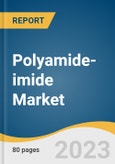The global automotive industry has been witnessing significant growth on account of low-cost manufacturing and government support in the form of tax benefits and financial incentives particularly in emerging Asian countries such as China, Indonesia, India, and Thailand. With an ongoing trend towards metal replacement in the automotive and aerospace industry, polyamide-imide molding resins have immense potential for components in engine parts and drive transmission parts that form 50% of the automotive component industry.
PAI polymers in fiber application also offer ample opportunity for the meta-aramid clothing industry. This material has heat and flame resistant characteristics and is one of the superior products used in the protective clothing industry. Growing demand for thermal protection clothing in the military, defense, chemical, and oil & gas industries is expected to steer polyamide-imide fiber demand over the next eight years.
Fiber application segment is expected to witness moderate growth rate over the next eight years. In terms of revenue, the segment is anticipated to grow at a CAGR of 7.1% over the forecast period. Surging demand for heat and flame resistant clothing in firefighting services, defense, and industrial sectors is expected to drive PAI-based fiber demand over the next eight years.
Polyamide-imide Market Report Highlights
- The molding resins dominated the market and accounted for a revenue share of 74.2% in 2023 due to its superior mechanical properties, chemical resistance, and processability, making it a versatile choice for a wide range of industries requiring high-performance materials.
- The wire enamels segment is expected to grow at the fastest CAGR of 7.7% from 2024 to 2030. This growth can be attributed to the increasing demand for high-performance wire enamels.
- North America held a substantial market share in the global polyamide-imide market in 2023. The increasing demand for lightweight materials in the automotive and aerospace industries, coupled with the growing need for high-performance plastics in various applications, has been driving the market growth.
- Asia Pacific polyamide-imide market is anticipated to witness the fastest CAGR in the coming years. This growth is owing to the growing applications in industries such as automotive, electronics, aerospace, and others.
The leading players in the Polyamide-Imide market include:
- Solvay
- Ensinger
- TOYOBO CO., LTD
- MITSUBISHI GAS CHEMICAL COMPANY, INC.
- Axalta Coating Systems Ltd.
- Kermel
- Drake Plastics
- Innotek Technology Limited
- Elantas GmbH
- Saint-Gobain
Why should you buy this report?
- Comprehensive Market Analysis: Gain detailed insights into the global market across major regions and segments.
- Competitive Landscape: Explore the market presence of key players worldwide.
- Future Trends: Discover the pivotal trends and drivers shaping the future of the global market.
- Actionable Recommendations: Utilize insights to uncover new revenue streams and guide strategic business decisions.
This report addresses:
- Market intelligence to enable effective decision-making
- Market estimates and forecasts from 2018 to 2030
- Growth opportunities and trend analyses
- Segment and regional revenue forecasts for market assessment
- Competition strategy and market share analysis
- Product innovation listing for you to stay ahead of the curve
- COVID-19's impact and how to sustain in these fast-evolving markets
This product will be delivered within 1-3 business days.
Table of Contents
Companies Mentioned
The leading players in the Polyamide-Imide market include:- Solvay
- Ensinger
- TOYOBO CO., LTD
- MITSUBISHI GAS CHEMICAL COMPANY, INC.
- Axalta Coating Systems Ltd.
- Kermel
- Drake Plastics
- Innotek Technology Limited
- Elantas GmbH
- Saint-Gobain
Methodology

LOADING...
Table Information
| Report Attribute | Details |
|---|---|
| No. of Pages | 100 |
| Published | September 2024 |
| Forecast Period | 2023 - 2030 |
| Estimated Market Value ( USD | $ 650 Million |
| Forecasted Market Value ( USD | $ 1057.5 Million |
| Compound Annual Growth Rate | 7.3% |
| Regions Covered | Global |
| No. of Companies Mentioned | 11 |









